Elucidating the Chemical Compositions and Source Apportionment of Multi-Size Atmospheric Particulate (PM10, PM2.5 and PM1) in 2019–2020 Winter in Xinxiang, North China
Abstract
:1. Introduction
2. Data and Methodology
2.1. Description of Station and Airborne Particles Sampling
2.2. Sample Analysis
2.3. Data Analysis Method
= 1.89 × Al + 2.14 × Si + 1.4 × Ca + 1.58 × Mn + 1.43 × Fe + 1.21 × K
2.4. Source Apportionment of Airborne Particles
2.5. Geographical Origins
3. Results and Discussion
3.1. Characteristics of PM10, PM2.5 and PM1
3.1.1. Mass Concentration and Chemical Species
3.1.2. Preliminary Source Identification
3.2. Heavy Pollution Periods Evaluation
3.3. PM Source Appointment
3.4. Geographical Origins of PM
4. Conclusions
Supplementary Materials
Author Contributions
Funding
Institutional Review Board Statement
Informed Consent Statement
Conflicts of Interest
References
- Hong, Y.; Cao, F.; Fan, M.-Y.; Lin, Y.-C.; Gul, C.; Yu, M.; Wu, X.; Zhai, X.; Zhang, Y.-L. Impacts of chemical degradation of levoglucosan on quantifying biomass burning contribution to carbonaceous aerosols: A case study in Northeast China. Sci. Total Environ. 2022, 819, 152007. [Google Scholar] [CrossRef] [PubMed]
- Liu, H.; Tian, H.; Zhang, K.; Liu, S.; Cheng, K.; Yin, S.; Liu, Y.; Liu, X.; Wu, Y.; Liu, W.; et al. Seasonal variation, formation mechanisms and potential sources of PM2.5 in two typical cities in the Central Plains Urban Agglomeration, China. Sci. Total Environ. 2018, 657, 657–670. [Google Scholar] [CrossRef]
- Zhang, J.; Yuan, Q.; Liu, L.; Wang, Y.; Zhang, Y.; Xu, L.; Pang, Y.; Zhu, Y.; Niu, H.; Shao, L.; et al. Trans-Regional Transport of Haze Particles from the North China Plain to Yangtze River Delta during Winter. J. Geophys. Res. Atmos. 2021, 126, e2020JD033778. [Google Scholar] [CrossRef]
- Zhao, B.; Zhao, J.; Zha, H.; Hu, R.; Liu, Y.; Liang, C.; Shi, H.; Chen, S.; Guo, Y.; Zhang, D.; et al. Health Benefits and Costs of Clean Heating Renovation: An Integrated Assessment in a Major Chinese City. Environ. Sci. Technol. 2021, 55, 10046–10055. [Google Scholar] [CrossRef]
- Wang, Y.; Li, W.; Gao, W.; Liu, Z.; Tian, S.; Shen, R.; Ji, D.; Wang, S.; Wang, L.; Tang, G.; et al. Trends in particulate matter and its chemical compositions in China from 2013–2017. Sci. China Earth Sci. 2019, 62, 1857–1871. [Google Scholar] [CrossRef]
- Liu, J.; Chen, Y.; Cao, H.; Zhang, A. Burden of typical diseases attributed to the sources of PM2.5-bound toxic metals in Beijing: An integrated approach to source apportionment and QALYs. Environ. Int. 2019, 131, 105041. [Google Scholar] [CrossRef] [PubMed]
- Zhao, B.; Zheng, H.; Wang, S.; Smith, K.R.; Lu, X.; Aunan, K.; Gu, Y.; Wang, Y.; Ding, D.; Xing, J.; et al. Change in household fuels dominates the decrease in PM2.5 exposure and premature mortality in China in 2005–2015. Proc. Natl. Acad. Sci. USA 2018, 115, 12401–12406. [Google Scholar] [CrossRef] [PubMed]
- Huang, X.; Liu, Z.; Liu, J.; Hu, B.; Wen, T.; Tang, G.; Zhang, J.; Wu, F.; Ji, D.; Wang, L.; et al. Chemical characterization and source identification of PM2.5 at multiple sites in the Beijing–Tianjin–Hebei region, China. Atmos. Chem. Phys. 2017, 17, 12941–12962. [Google Scholar] [CrossRef]
- Jiang, H.; Liao, H.; Pye, H.O.T.; Wu, S.; Mickley, L.J.; Seinfeld, J.H.; Zhang, X.Y. Projected effect of 2000–2050 changes in climate and emissions on aerosol levels in China and associated transboundary transport. Atmos. Chem. Phys. 2013, 13, 7937–7960. [Google Scholar] [CrossRef]
- Li, Y.; Huang, H.X.; Griffith, S.M.; Wu, C.; Lau, A.K.; Yu, J.Z. Quantifying the relationship between visibility degradation and PM2.5 constituents at a suburban site in Hong Kong: Differentiating contributions from hydrophilic and hydrophobic organic compounds. Sci. Total Environ. 2017, 575, 1571–1581. [Google Scholar] [CrossRef]
- Geng, G.; Zheng, Y.; Zhang, Q.; Xue, T.; Zhao, H.; Tong, D.; Zheng, B.; Li, M.; Liu, F.; Hong, C.; et al. Drivers of PM2.5 air pollution deaths in China 2002–2017. Nat. Geosci. 2021, 14, 645–650. [Google Scholar] [CrossRef]
- Li, J.; Zhang, Y.-L.; Cao, F.; Zhang, W.; Fan, M.; Lee, X.; Michalski, G. Stable Sulfur Isotopes Revealed a Major Role of Transition-Metal Ion-Catalyzed SO2 Oxidation in Haze Episodes. Environ. Sci. Technol. 2020, 54, 2626–2634. [Google Scholar] [CrossRef] [PubMed]
- Li, M.; Wang, L.; Liu, J.; Gao, W.; Song, T.; Sun, Y.; Li, L.; Li, X.; Wang, Y.; Liu, L.; et al. Exploring the regional pollution characteristics and meteorological formation mechanism of PM2.5 in North China during 2013–2017. Environ. Int. 2019, 134, 105283. [Google Scholar] [CrossRef]
- Liu, T.; Clegg, S.L.; Abbatt, J.P.D. Fast oxidation of sulfur dioxide by hydrogen peroxide in deliquesced aerosol particles. Proc. Natl. Acad. Sci. USA 2020, 117, 1354–1359. [Google Scholar] [CrossRef]
- Zhang, F.; Wang, Y.; Peng, J.; Chen, L.; Sun, Y.; Duan, L.; Ge, X.; Li, Y.; Zhao, J.; Liu, C.; et al. An unexpected catalyst dominates formation and radiative forcing of regional haze. Proc. Natl. Acad. Sci. USA 2020, 117, 3960–3966. [Google Scholar] [CrossRef] [PubMed]
- Wang, J.; Ye, J.; Zhang, Q.; Zhao, J.; Wu, Y.; Li, J.; Liu, D.; Li, W.; Zhang, Y.; Wu, C.; et al. Aqueous production of secondary organic aerosol from fossil-fuel emissions in winter Beijing haze. Proc. Natl. Acad. Sci. USA 2021, 118, e2022179118. [Google Scholar] [CrossRef]
- Zhang, Y.; Ren, H.; Sun, Y.; Cao, F.; Chang, Y.; Liu, S.; Lee, X.; Agrios, K.; Kawamura, K.; Liu, D.; et al. High Contribution of Nonfossil Sources to Submicrometer Organic Aerosols in Beijing, China. Environ. Sci. Technol. 2017, 51, 7842–7852. [Google Scholar] [CrossRef]
- Zhou, W.; Wang, Q.; Zhao, X.; Xu, W.; Chen, C.; Du, W.; Zhao, J.; Canonaco, F.; Prévôt, A.S.H.; Fu, P.; et al. Characterization and source apportionment of organic aerosol at 260 m on a meteorological tower in Beijing, China. Atmos. Chem. Phys. 2018, 18, 3951–3968. [Google Scholar] [CrossRef]
- Rattanavaraha, W.; Canagaratna, M.R.; Budisulistiorini, S.H.; Croteau, P.L.; Baumann, K.; Canonaco, F.; Prevot, A.S.; Edgerton, E.S.; Zhang, Z.; Jayne, J.T.; et al. Source apportionment of submicron organic aerosol collected from Atlanta, Georgia, during 2014–2015 using the aerosol chemical speciation monitor (ACSM). Atmos. Environ. 2017, 167, 389–402. [Google Scholar] [CrossRef]
- Du, A.; Li, Y.; Sun, J.; Zhang, Z.; You, B.; Li, Z.; Chen, C.; Li, J.; Qiu, Y.; Liu, X.; et al. Rapid transition of aerosol optical properties and water-soluble organic aerosols in cold season in Fenwei Plain. Sci. Total Environ. 2022, 829, 154661. [Google Scholar] [CrossRef]
- Sun, Y.; Lei, L.; Zhou, W.; Chen, C.; He, Y.; Sun, J.; Li, Z.; Xu, W.; Wang, Q.; Ji, D.; et al. A chemical cocktail during the COVID-19 outbreak in Beijing, China: Insights from six-year aerosol particle composition measurements during the Chinese New Year holiday. Sci. Total Environ. 2020, 742, 140739. [Google Scholar] [CrossRef]
- Yan, G.; Zhang, J.; Zhang, P.; Cao, Z.; Zhu, G.; Liu, Z.; Wang, Y. Episode-Based Analysis of Size-Resolved Carbonaceous Aerosol Compositions in Wintertime of Xinxiang: Implication for the Haze Formation Processes in Central China. Appl. Sci. 2020, 10, 3498. [Google Scholar] [CrossRef]
- Feng, J.; Yu, H.; Su, X.; Liu, S.; Li, Y.; Pan, Y.; Sun, J.-H. Chemical composition and source apportionment of PM2.5 during Chinese Spring Festival at Xinxiang, a heavily polluted city in North China: Fireworks and health risks. Atmos. Res. 2016, 182, 176–188. [Google Scholar] [CrossRef]
- Shao, P.; Tian, H.; Sun, Y.; Liu, H.; Wu, B.; Liu, S.; Liu, X.; Wu, Y.; Liang, W.; Wang, Y.; et al. Characterizing remarkable changes of severe haze events and chemical compositions in multi-size airborne particles (PM1, PM2.5 and PM10) from January 2013 to 2016–2017 winter in Beijing, China. Atmos. Environ. 2018, 189, 133–144. [Google Scholar] [CrossRef]
- Gao, J.; Wang, K.; Wang, Y.; Liu, S.; Zhu, C.; Hao, J.; Liu, H.; Hua, S.; Tian, H. Temporal-spatial characteristics and source apportionment of PM2.5 as well as its associated chemical species in the Beijing-Tianjin-Hebei region of China. Environ. Pollut. 2017, 233, 714–724. [Google Scholar] [CrossRef]
- Aiken, A.C.; DeCarlo, P.F.; Kroll, J.H.; Worsnop, D.R.; Huffman, J.A.; Docherty, K.S.; Ulbrich, I.M.; Mohr, C.; Kimmel, J.R.; Sueper, D.; et al. O/C and OM/OC Ratios of Primary, Secondary, and Ambient Organic Aerosols with High-Resolution Time-of-Flight Aerosol Mass Spectrometry. Environ. Sci. Technol. 2008, 42, 4478–4485. [Google Scholar] [CrossRef]
- Dai, Q.; Bi, X.; Liu, B.; Li, L.; Ding, J.; Song, W.; Bi, S.; Schulze, B.C.; Song, C.; Wu, J.; et al. Chemical nature of PM2.5 and PM10 in Xi’an, China: Insights into primary emissions and secondary particle formation. Environ. Pollut. 2018, 240, 155–166. [Google Scholar] [CrossRef]
- Sun, Y.; Du, W.; Fu, P.; Wang, Q.; Li, J.; Ge, X.; Zhang, Q.; Zhu, C.; Ren, L.; Xu, W.; et al. Primary and secondary aerosols in Beijing in winter: Sources, variations and processes. Atmos. Chem. Phys. 2016, 16, 8309–8329. [Google Scholar] [CrossRef]
- Bressi, M.; Sciare, J.; Ghersi, V.; Bonnaire, N.; Nicolas, J.B.; Petit, J.-E.; Moukhtar, S.; Rosso, A.; Mihalopoulos, N.; Féron, A. A one-year comprehensive chemical characterisation of fine aerosol (PM2.5) at urban, suburban and rural background sites in the region of Paris (France). Atmos. Chem. Phys. 2013, 13, 7825–7844. [Google Scholar] [CrossRef]
- Tan, T.; Hu, M.; Li, M.; Guo, Q.; Wu, Y.; Fang, X.; Gu, F.; Wang, Y.; Wu, Z. New insight into PM2.5 pollution patterns in Beijing based on one-year measurement of chemical compositions. Sci. Total Environ. 2018, 621, 734–743. [Google Scholar] [CrossRef]
- Taylor, S.R.; McLennan, S.M. The continental crust: Its composition and evolution. J. Jeol. 1985, 94, 57–72. [Google Scholar]
- Chen, C.; Zhang, H.; Li, H.; Wu, N.; Zhang, Q. Chemical characteristics and source apportionment of ambient PM1.0 and PM2.5 in a polluted city in North China plain. Atmos. Environ. 2020, 242, 117867. [Google Scholar] [CrossRef]
- Gu, Y.; Liu, B.; Dai, Q.; Zhang, Y.; Zhou, M.; Feng, Y.; Hopke, P.K. Multiply improved positive matrix factorization for source apportionment of volatile organic compounds during the COVID-19 shutdown in Tianjin, China. Environ. Int. 2021, 158, 106979. [Google Scholar] [CrossRef] [PubMed]
- United States Environmental Protection Agency (USEPA). Positive Matrix Factorization (PMF) 5.0 Fundamentals and User Guide; US Environmental Protection Agency: Washington, DC, USA, 2014.
- Polissar, A.V.; Hopke, P.K.; Paatero, P.; Malm, W.C.; Sisler, J.F. Atmospheric aerosol over Alaska: 2. Elemental composition and sources. J. Geophys. Res. Earth Surf. 1998, 103, 19045–19057. [Google Scholar] [CrossRef]
- Liu, J.W.; Chen, Y.J.; Chao, S.H.; Chao, H.B.; Zhang, A.C.; Yang, Y. Emission control priority of PM2.5-bound heavy metals in different seasons: A comprehensive analysis from health risk perspective. Sci. Total Environ. 2018, 644, 20–30. [Google Scholar] [CrossRef]
- Zhang, Y.; Lang, J.; Cheng, S.; Li, S.; Zhou, Y.; Chen, D.; Zhang, H.; Wang, H. Chemical composition and sources of PM1 and PM2.5 in Beijing in autumn. Sci. Total Environ. 2018, 630, 72–82. [Google Scholar] [CrossRef] [PubMed]
- Lang, J.; Li, S.; Cheng, S.; Zhou, Y.; Chen, D.; Zhang, Y.; Zhang, H.; Wang, H. Chemical Characteristics and Sources of Submicron Particles in a City with Heavy Pollution in China. Atmosphere 2018, 9, 388. [Google Scholar] [CrossRef]
- Ji, D.; Gao, W.; Maenhaut, W.; He, J.; Wang, Z.; Li, J.; Du, W.; Wang, L.; Sun, Y.; Xin, J.; et al. Impact of air pollution control measures and regional transport on carbonaceous aerosols in fine particulate matter in urban Beijing, China: Insights gained from long-term measurement. Atmos. Chem. Phys. 2019, 19, 8569–8590. [Google Scholar] [CrossRef]
- Zhang, Y.; Chen, J.; Yang, H.; Li, R.; Yu, Q. Seasonal variation and potential source regions of PM2.5-bound PAHs in the megacity Beijing, China: Impact of regional transport. Environ. Pollut. 2017, 231, 329–338. [Google Scholar] [CrossRef]
- Wang, Y.Q.; Zhang, X.Y.; Draxler, R.R. TrajStat: GIS-based software that uses various trajectory statistical analysis methods to identify potential sources from long-term air pollution measurement data. Environ. Model. Softw. 2009, 24, 938–939. [Google Scholar] [CrossRef]
- Du, T.; Wang, M.; Guan, X.; Zhang, M.; Zeng, H.; Chang, Y.; Zhang, L.; Tian, P.; Shi, J.; Tang, C. Characteristics and Formation Mechanisms of Winter Particulate Pollution in Lanzhou, Northwest China. J. Geophys. Res. Atmos. 2020, 125, e2020JD033369. [Google Scholar] [CrossRef]
- Li, Y.; Du, A.; Li, Z.; Li, J.; Chen, C.; Sun, J.; Qiu, Y.; Zhang, Z.; Wang, Q.; Xu, W.; et al. Investigation of sources and formation mechanisms of fine particles and organic aerosols in cold season in Fenhe Plain, China. Atmos. Res. 2022, 268, 106018. [Google Scholar] [CrossRef]
- Guo, S.; Hu, M.; Wang, Z.B.; Slanina, J.; Zhao, Y.L. Size-resolved aerosol water-soluble ionic compositions in the summer of Beijing: Implication of regional secondary formation. Atmos. Chem. Phys. 2010, 10, 947–959. [Google Scholar] [CrossRef]
- Cheng, Y.; Zheng, G.; Wei, C.; Mu, Q.; Zheng, B.; Wang, Z.; Gao, M.; Zhang, Q.; He, K.; Carmichael, G.; et al. Reactive nitrogen chemistry in aerosol water as a source of sulfate during haze events in China. Sci. Adv. 2016, 2, e1601530. [Google Scholar] [CrossRef] [PubMed]
- Wang, G.; Zhang, R.; Gomez, M.E.; Yang, L.; Zamora, M.L.; Hu, M.; Lin, Y.; Peng, J.; Guo, S.; Meng, J.; et al. Persistent sulfate formation from London Fog to Chinese haze. Proc. Natl. Acad. Sci. USA 2016, 113, 13630–13635. [Google Scholar] [CrossRef] [PubMed]
- Gao, J.; Tian, H.; Cheng, K.; Lu, L.; Wang, Y.; Wu, Y.; Zhu, C.; Liu, K.; Zhou, J.; Liu, X.; et al. Seasonal and spatial variation of trace elements in multi-size airborne particulate matters of Beijing, China: Mass concentration, enrichment characteristics, source apportionment, chemical speciation and bioavailability. Atmos. Environ. 2014, 99, 257–265. [Google Scholar] [CrossRef]
- Tian, H.Z.; Zhu, C.Y.; Gao, J.J.; Cheng, K.; Hao, J.M.; Wang, K.; Hua, S.B.; Wang, Y.; Zhou, J.R. Quantitative assessment of atmospheric emissions of toxic heavy metals from anthropogenic sources in China: Historical trend, spatial distribution, uncertainties, and control policies. Atmos. Chem. Phys. 2015, 15, 10127–10147. [Google Scholar] [CrossRef]
- Zhu, C.; Tian, H.; Hao, J. Global anthropogenic atmospheric emission inventory of twelve typical hazardous trace elements, 1995–2012. Atmos. Environ. 2020, 220, 117061. [Google Scholar] [CrossRef]
- Zhu, C.; Tian, H.; Hao, Y.; Gao, J.; Hao, J.; Wang, Y.; Hua, S.; Wang, K.; Liu, H. A high-resolution emission inventory of anthropogenic trace elements in Beijing-Tianjin-Hebei (BTH) region of China. Atmos. Environ. 2018, 191, 452–462. [Google Scholar] [CrossRef]
- Liu, H.J.; Jia, M.K.; Liu, Y.L.; Zhao, Y.J.; Zheng, A.H.; Liu, H.Z.; Xu, S.Y.; Xiao, Q.Q.; Su, X.Y.; Ren, Y. Seasonal variation, source identification, and health risk of PM2.5–bound metals in Xinxiang. Environ. Sci. 2021, 42, 4140–4150. (In Chinese) [Google Scholar] [CrossRef]
- Cui, Y.; Ji, D.; Maenhaut, W.; Gao, W.; Zhang, R.; Wang, Y. Levels and sources of hourly PM2.5-related elements during the control period of the COVID-19 pandemic at a rural site between Beijing and Tianjin. Sci. Total Environ. 2020, 744, 140840. [Google Scholar] [CrossRef]
- Kong, L.; Feng, M.; Liu, Y.; Zhang, Y.; Zhang, C.; Li, C.; Qu, Y.; An, J.; Liu, X.; Tan, Q.; et al. Elucidating the pollution characteristics of nitrate, sulfate and ammonium in PM2.5 in Chengdu, southwest China, based on 3-year measurements. Atmos. Chem. Phys. 2020, 20, 11181–11199. [Google Scholar] [CrossRef]
- Zhang, X.; Li, Z.; Wang, F.; Song, M.; Zhou, X.; Ming, J. Carbonaceous Aerosols in PM1, PM2.5, and PM10 Size Fractions over the Lanzhou City, Northwest China. Atmosphere 2020, 11, 1368. [Google Scholar] [CrossRef]
- Vu, T.V.; Shi, Z.; Cheng, J.; Zhang, Q.; He, K.; Wang, S.; Harrison, R.M. Assessing the impact of clean air action on air quality trends in Beijing using a machine learning technique. Atmos. Chem. Phys. 2019, 19, 11303–11314. [Google Scholar] [CrossRef]
- Sun, Y.; Chen, C.; Zhang, Y.; Xu, W.; Zhou, L.; Cheng, X.; Zheng, H.; Ji, D.; Li, J.; Tang, X.; et al. Rapid formation and evolution of an extreme haze episode in Northern China during winter 2015. Sci. Rep. 2016, 6, 27151. [Google Scholar] [CrossRef] [PubMed]
- Fu, X.; Wang, T.; Gao, J.; Wang, P.; Liu, Y.; Wang, S.; Zhao, B.; Xue, L. Persistent Heavy Winter Nitrate Pollution Driven by Increased Photochemical Oxidants in Northern China. Environ. Sci. Technol. 2020, 54, 3881–3889. [Google Scholar] [CrossRef]
- Sun, Y.; Zhuang, G.; Tang, A.; Wang, Y.; An, Z. Chemical Characteristics of PM2.5 and PM10 in Haze−Fog Episodes in Beijing. Environ. Sci. Technol. 2006, 40, 3148–3155. [Google Scholar] [CrossRef]
- Duan, J.; Tan, J. Atmospheric heavy metals and Arsenic in China: Situation, sources and control policies. Atmos. Environ. 2013, 74, 93–101. [Google Scholar] [CrossRef]
- Blitz, M.A.; Hughes, K.J.; Pilling, M.J. Determination of the High-Pressure Limiting Rate Coefficient and the Enthalpy of Reaction for OH + SO2. J. Phys. Chem. A 2003, 107, 1971–1978. [Google Scholar] [CrossRef]
- Calvert, J.G.; Stockwell, W.R. Acid generation in the troposphere by gas-phase chemistry. Environ. Sci. Technol. 1983, 17, 428A–443A. [Google Scholar] [CrossRef]
- Ianniello, A.; Spataro, F.; Esposito, G.; Allegrini, I.; Hu, M.; Zhu, T. Chemical characteristics of inorganic ammonium salts in PM2.5 in the atmosphere of Beijing (China). Atmos. Chem. Phys. 2011, 11, 10803–10822. [Google Scholar] [CrossRef] [Green Version]
- Tian, Y.Z.; Wang, J.; Peng, X.; Shi, G.L.; Feng, Y.C. Estimation of the direct and indirect impacts of fireworks on the physicochemical characteristics of atmospheric PM10 and PM2.5. Atmos. Chem. Phys. 2014, 14, 9469–9479. [Google Scholar] [CrossRef]
- Pérez, N.; Pey, J.; Reche, C.; Cortés, J.; Alastuey, A.; Querol, X. Impact of harbour emissions on ambient PM10 and PM2.5 in Barcelona (Spain): Evidences of secondary aerosol formation within the urban area. Sci. Total Environ. 2016, 571, 237–250. [Google Scholar] [CrossRef] [PubMed]
- Pandolfi, M.; Castanedo, Y.G.; Alastuey, A.; de la Rosa, J.D.; Mantilla, E.; de la Campa, A.M.S.; Querol, X.; Pey, J.; Amato, F.; Moreno, T. Source apportionment of PM10 and PM2.5 at multiple sites in the strait of Gibraltar by PMF: Impact of shipping emissions. Environ. Sci. Pollut. Res. 2010, 18, 260–269. [Google Scholar] [CrossRef]
- Chang, Y.; Huang, K.; Xie, M.; Deng, C.; Zou, Z.; Liu, S.; Zhang, Y. First long-term and near real-time measurement of trace elements in China’s urban atmosphere: Temporal variability, source apportionment and precipitation effect. Atmos. Chem. Phys. 2018, 18, 11793–11812. [Google Scholar] [CrossRef]
- Gu, X.; Yin, S.; Lu, X.; Zhang, H.; Wang, L.; Bai, L.; Wang, C.; Zhang, R.; Yuan, M. Recent development of a refined multiple air pollutant emission inventory of vehicles in the Central Plains of China. J. Environ. Sci. 2019, 84, 80–96. [Google Scholar] [CrossRef]
- Jiang, P.; Zhong, X.; Li, L. On-road vehicle emission inventory and its spatio-temporal variations in North China Plain. Environ. Pollut. 2020, 267, 115639. [Google Scholar] [CrossRef] [PubMed]
- Liao, K.; Chen, Q.; Liu, Y.; Li, Y.J.; Lambe, A.T.; Zhu, T.; Huang, R.-J.; Zheng, Y.; Cheng, X.; Miao, R.; et al. Secondary Organic Aerosol Formation of Fleet Vehicle Emissions in China: Potential Seasonality of Spatial Distributions. Environ. Sci. Technol. 2021, 55, 7276–7286. [Google Scholar] [CrossRef]
- Theodosi, C.; Tsagkaraki, M.; Zarmpas, P.; Grivas, G.; Liakakou, E.; Paraskevopoulou, D.; Lianou, M.; Gerasopoulos, E.; Mihalopoulos, N. Multi-year chemical composition of the fine-aerosol fraction in Athens, Greece, with emphasis on the contribution of residential heating in wintertime. Atmos. Chem. Phys. 2018, 18, 14371–14391. [Google Scholar] [CrossRef]
- Huang, S.; Wu, Z.; Poulain, L.; van Pinxteren, M.; Merkel, M.; Assmann, D.; Herrmann, H.; Wiedensohler, A. Source apportionment of the organic aerosol over the Atlantic Ocean from 53° N to 53° S: Significant contributions from marine emissions and long-range transport. Atmos. Chem. Phys. 2018, 18, 18043–18062. [Google Scholar] [CrossRef]
- Mugica-Álvarez, V.; Figueroa-Lara, J.; Romero-Romo, M.; Sepúlveda-Sánchez, J.; López-Moreno, T. Concentrations and properties of airborne particles in the Mexico City subway system. Atmos. Environ. 2012, 49, 284–293. [Google Scholar] [CrossRef]
- Taghvaee, S.; Sowlat, M.H.; Mousavi, A.; Hassanvand, M.S.; Yunesian, M.; Naddafi, K.; Sioutas, C. Source apportionment of ambient PM2.5 in two locations in central Tehran using the Positive Matrix Factorization (PMF) model. Sci. Total Environ. 2018, 628–629, 672–686. [Google Scholar] [CrossRef] [PubMed]
- Huang, X.-F.; Zou, B.-B.; He, L.-Y.; Hu, M.; Prévôt, A.S.H.; Zhang, Y.-H. Exploration of PM2.5 sources on the regional scale in the Pearl River Delta based on ME-2 modeling. Atmos. Chem. Phys. 2018, 18, 11563–11580. [Google Scholar] [CrossRef]
- Zhou, S.; Davy, P.K.; Huang, M.; Duan, J.; Wang, X.; Fan, Q.; Chang, M.; Liu, Y.; Chen, W.; Xie, S.; et al. High-resolution sampling and analysis of ambient particulate matter in the Pearl River Delta region of southern China: Source apportionment and health risk implications. Atmos. Chem. Phys. 2018, 18, 2049–2064. [Google Scholar] [CrossRef]
- Dao, X.; Ji, D.; Zhang, X.; He, J.; Sun, J.; Hu, J.; Liu, Y.; Wang, L.; Xu, X.; Tang, G.; et al. Significant reduction in atmospheric organic and elemental carbon in PM2.5 in 2 + 26 cities in northern China. Environ. Res. 2022, 211, 113055. [Google Scholar] [CrossRef]
- Liu, S.; Hua, S.; Wang, K.; Qiu, P.; Liu, H.; Wu, B.; Shao, P.; Liu, X.; Wu, Y.; Xue, Y.; et al. Spatial-temporal variation characteristics of air pollution in Henan of China: Localized emission inventory, WRF/Chem simulations and potential source contribution analysis. Sci. Total Environ. 2018, 624, 396–406. [Google Scholar] [CrossRef]
- Wang, L.; Wei, Z.; Wei, W.; Fu, J.S.; Meng, C.; Ma, S. Source apportionment of PM2.5 in top polluted cities in Hebei, China using the CMAQ model. Atmos. Environ. 2015, 122, 723–736. [Google Scholar] [CrossRef]


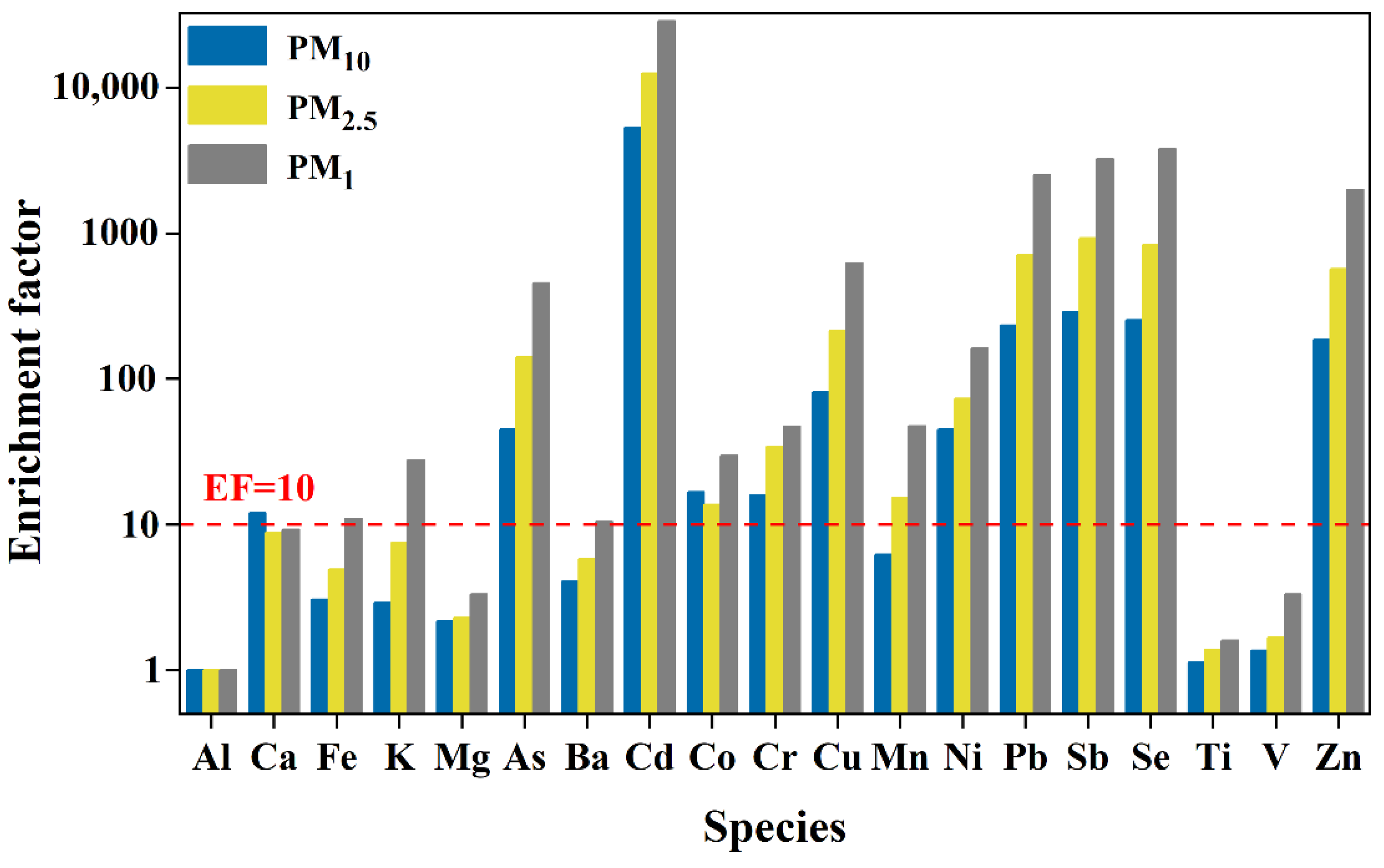
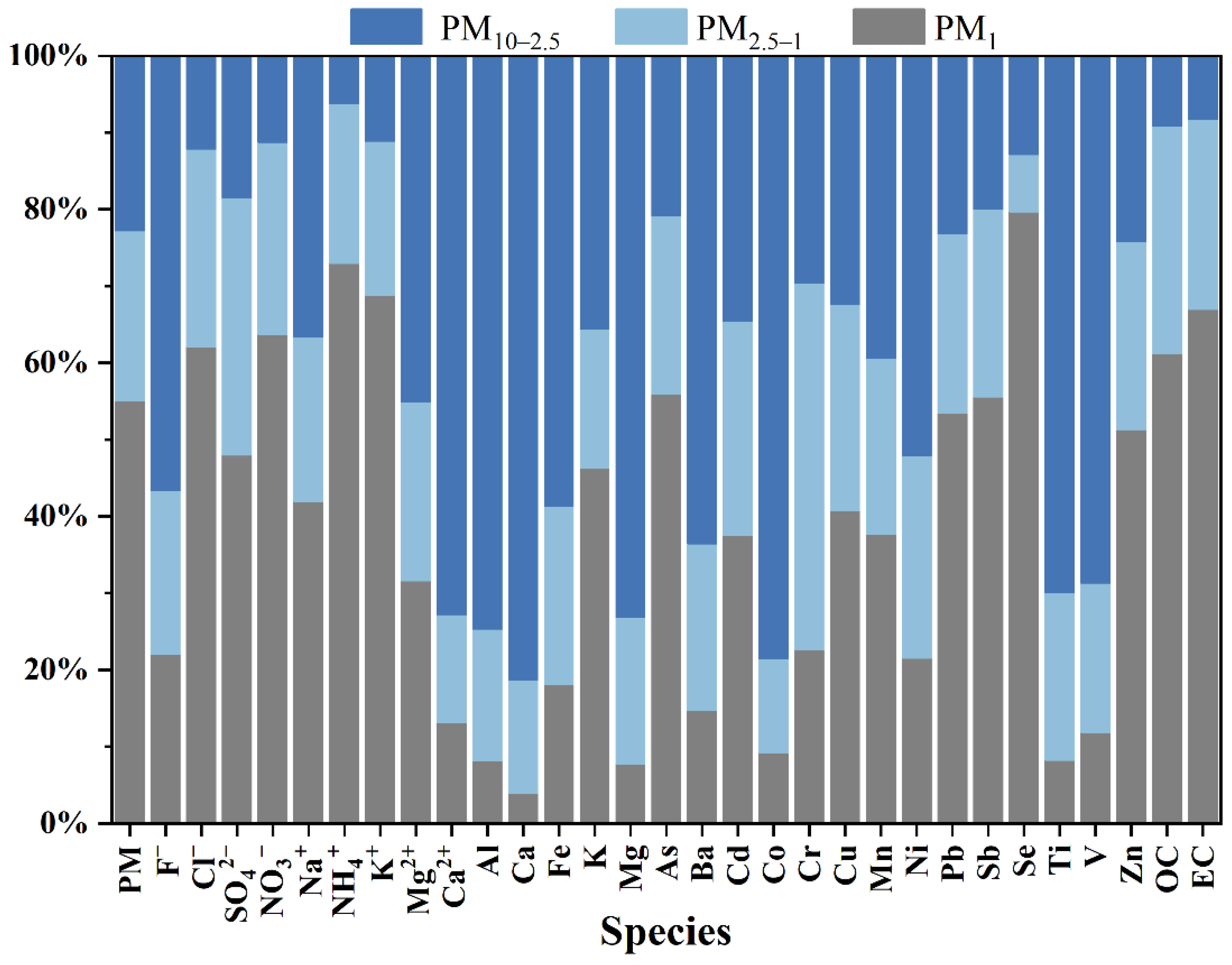
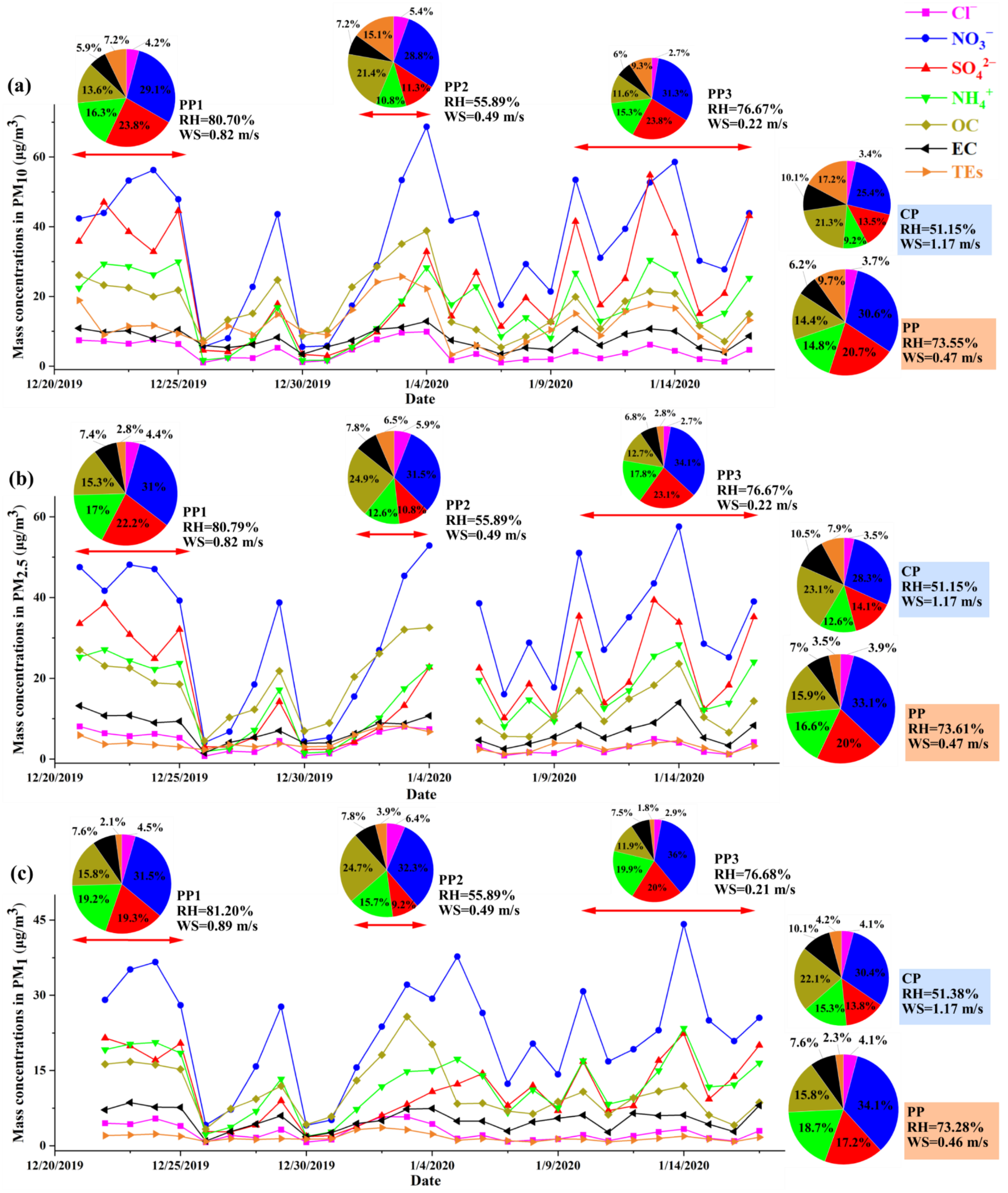

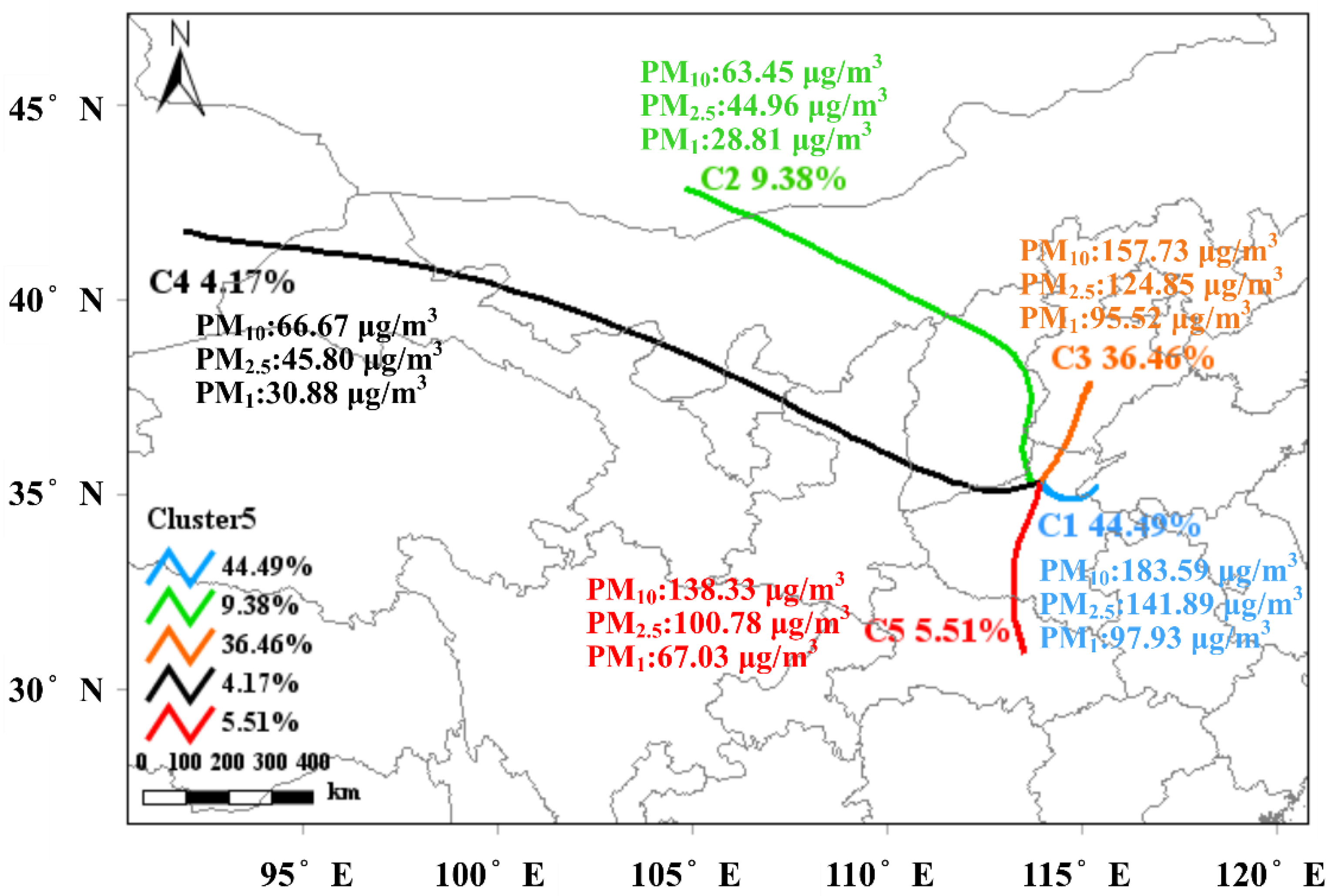
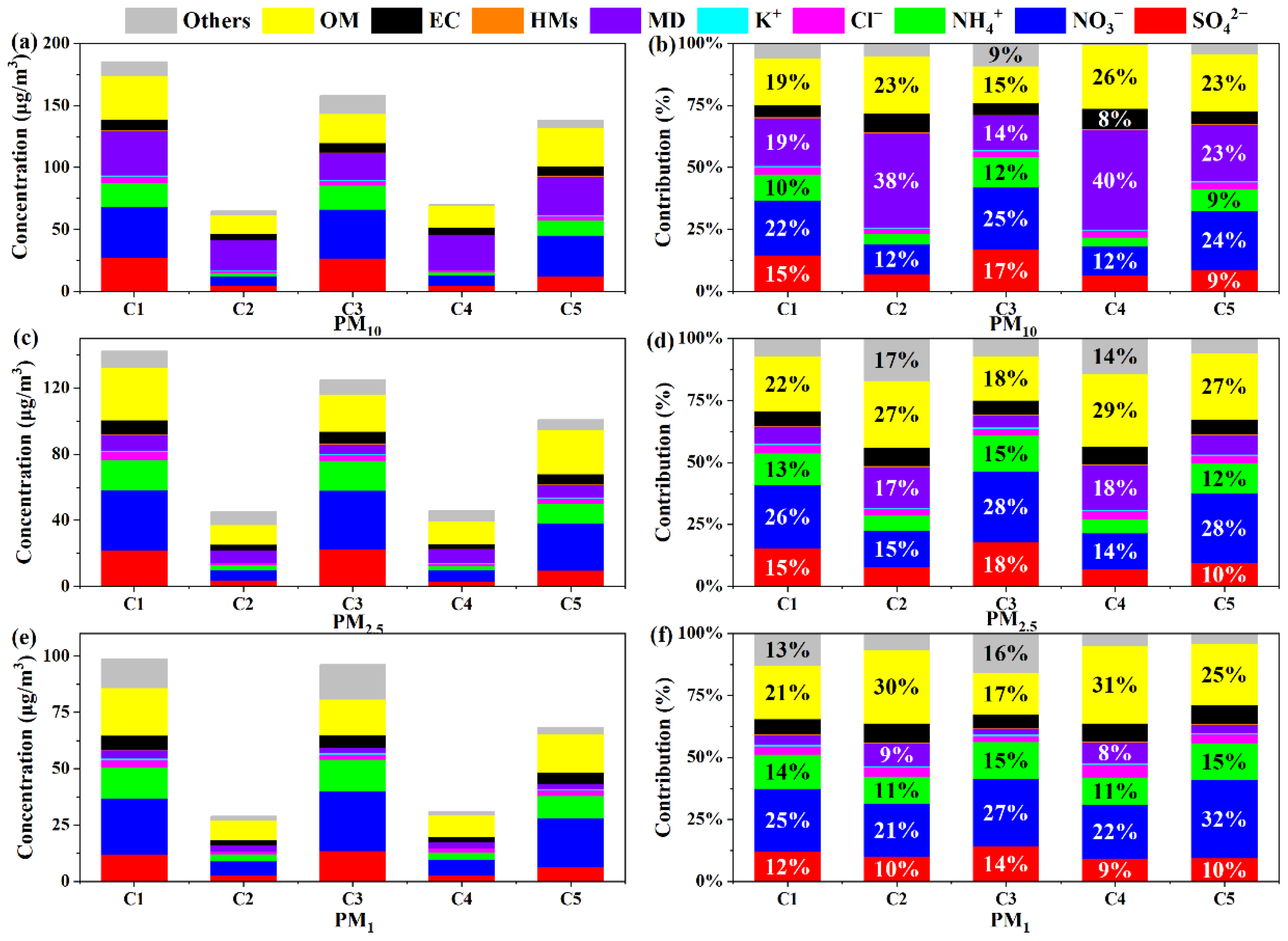
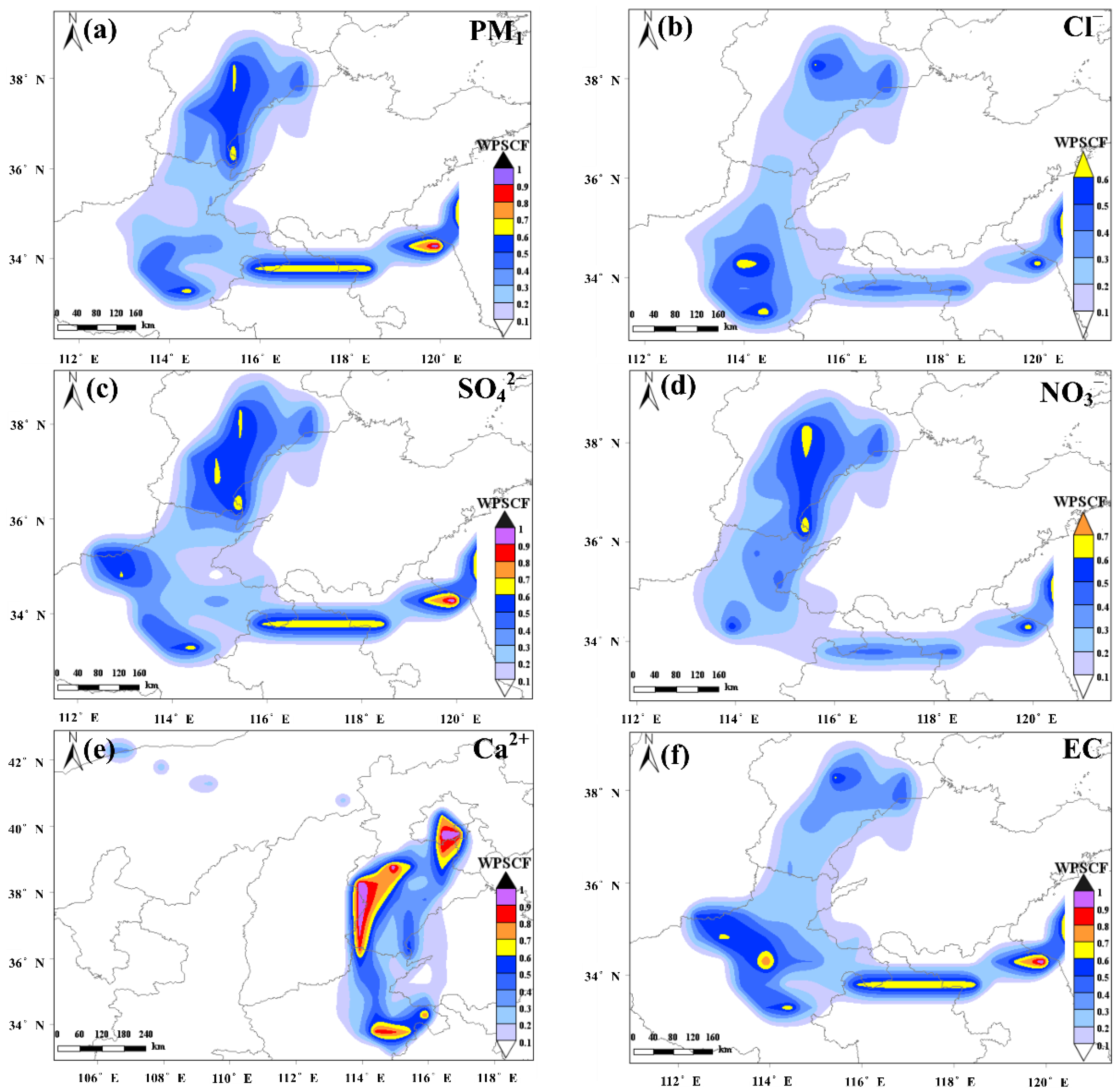
| Species | PM10 | PM2.5 | PM1 | |||
|---|---|---|---|---|---|---|
| Average ± SD | Range | Average ± SD | Range | Average ± SD | Range | |
| PM | 155.53 ± 66.22 | 45.84–292.62 | 120.07 ± 52.86 | 30.53–197.08 | 85.64 ± 41.49 | 19.37–161.01 |
| OM | 28.14 ± 13.54 | 8.61–62.12 | 25.57 ± 13.12 | 7.22–52.09 | 17.22 ± 8.70 | 5.32–41.19 |
| EC | 7.72 ± 2.69 | 3.40–12.86 | 7.08 ± 3.22 | 1.54–13.96 | 5.17 ± 2.07 | 0.94–8.63 |
| Cl− | 4.25 ± 2.69 | 1.03–9.86 | 3.73 ± 2.37 | 0.72–8.08 | 2.64 ± 1.62 | 0.72–5.81 |
| SO42− | 23.03 ± 15.35 | 2.90–54.79 | 18.77 ± 12.41 | 2.35–39.35 | 11.05 ± 6.52 | 1.86–22.38 |
| NO3− | 35.49 ± 17.72 | 5.52–68.67 | 31.49 ± 16.06 | 4.06–57.59 | 22.61 ± 10.61 | 4.06–44.17 |
| Na+ | 0.54 ± 0.24 | 0.18–1.07 | 0.34 ± 0.15 | 0.11–0.70 | 0.23 ± 0.08 | 0.09–0.37 |
| NH4+ | 16.68 ± 9.72 | 1.63–30.43 | 15.64 ± 8.76 | 1.49–28.36 | 12.16 ± 6.01 | 1.85–23.43 |
| K+ | 0.82 ± 0.42 | 0.13–1.62 | 0.73 ± 0.36 | 0.10–1.32 | 0.57 ± 0.25 | 0.10–0.91 |
| Mg2+ | 0.25 ± 0.12 | 0.07–0.45 | 0.14 ± 0.06 | 0.04–0.25 | 0.08 ± 0.03 | 0.02–0.14 |
| Ca2+ | 4.99 ± 2.49 | 0.95–10.49 | 1.36 ± 0.60 | 0.39 – 2.82 | 0.66 ± 0.18 | 0.40–1.14 |
| Al | 1.79 ± 0.89 | 0.29–3.52 | 0.45 ± 0.22 | 0.12–1.03 | 0.14 ± 0.16 | 0.02–0.86 |
| Fe | 2.09 ± 0.91 | 0.68–4.48 | 0.86 ± 0.48 | 0.30–2.47 | 0.38 ± 0.22 | 0.14–1.06 |
| As | 0.01 ± 0.01 | 0.004–0.031 | 0.009 ± 0.006 | 0.002–0.027 | 0.007 ± 0.004 | 0.002–0.015 |
| Ba | 0.05 ± 0.03 | 0.01–0.13 | 0.02 ± 0.01 | 0.003–0.039 | 0.007 ± 0.005 | 0.001–0.023 |
| Cd | 0.008 ± 0.007 | 0.001–0.038 | 0.005 ± 0.005 | 0.001–0.028 | 0.003 ± 0.003 | 0.001–0.017 |
| Co | 0.004 ± 0.005 | 0.001–0.025 | 0.001 ± 0.001 | 0.0002–0.0039 | 0.0004 ± 0.0002 | 0.0002–0.0014 |
| Cr | 0.02 ± 0.01 | 0.01–0.04 | 0.01 ± 0.01 | 0.001–0.041 | 0.005 ± 0.005 | 0.0002–0.0224 |
| Cu | 0.04 ± 0.03 | 0.01–0.14 | 0.02 ± 0.02 | 0.01–0.09 | 0.01 ± 0.01 | 0.004–0.044 |
| Mn | 0.09 ± 0.05 | 0.03–0.23 | 0.05 ± 0.03 | 0.02–0.14 | 0.03 ± 0.02 | 0.01–0.08 |
| Ni | 0.02 ± 0.02 | 0.004–0.076 | 0.01 ± 0.01 | 0.001–0.046 | 0.004 ± 0.003 | 0.0002–0.0117 |
| Pb | 0.10 ± 0.05 | 0.03–0.26 | 0.08 ± 0.04 | 0.02–0.19 | 0.05 ± 0.02 | 0.02–0.11 |
| Sb | 0.01 ± 0.01 | 0.002–0.025 | 0.008 ± 0.005 | 0.003–0.018 | 0.006 ± 0.003 | 0.002–0.011 |
| Se | 0.0012 ± 0.0003 | 0.001–0.002 | 0.0011 ± 0.0003 | 0.0007–0.0018 | 0.0010 ± 0.0001 | 0.0008–0.0013 |
| Ti | 0.13 ± 0.06 | 0.03–0.23 | 0.04 ± 0.02 | 0.02–0.09 | 0.01 ± 0.01 | 0.003–0.030 |
| V | 0.003 ± 0.001 | 0.001–0.006 | 0.001 ± 0.001 | 0.0003–0.0024 | 0.0004 ± 0.0003 | 0.0001–0.0015 |
| Zn | 0.26 ± 0.16 | 0.05–0.62 | 0.20 ± 0.11 | 0.03–0.47 | 0.13 ± 0.06 | 0.04–0.25 |
| MD | 28.80 ± 14.14 | 5.14–59.66 | 7.90 ± 3.69 | 2.31–17.62 | 2.93 ± 1.98 | 0.99–10.50 |
| THMs | 12.06 ± 6.00 | 2.39–25.68 | 3.80 ± 1.80 | 1.25–8.15 | 1.65 ± 0.75 | 0.76–3.61 |
Publisher’s Note: MDPI stays neutral with regard to jurisdictional claims in published maps and institutional affiliations. |
© 2022 by the authors. Licensee MDPI, Basel, Switzerland. This article is an open access article distributed under the terms and conditions of the Creative Commons Attribution (CC BY) license (https://creativecommons.org/licenses/by/4.0/).
Share and Cite
Liu, H.; Jia, M.; You, K.; Wang, J.; Tao, J.; Liu, H.; Zhang, R.; Li, L.; Xu, M.; Ren, Y.; et al. Elucidating the Chemical Compositions and Source Apportionment of Multi-Size Atmospheric Particulate (PM10, PM2.5 and PM1) in 2019–2020 Winter in Xinxiang, North China. Atmosphere 2022, 13, 1400. https://doi.org/10.3390/atmos13091400
Liu H, Jia M, You K, Wang J, Tao J, Liu H, Zhang R, Li L, Xu M, Ren Y, et al. Elucidating the Chemical Compositions and Source Apportionment of Multi-Size Atmospheric Particulate (PM10, PM2.5 and PM1) in 2019–2020 Winter in Xinxiang, North China. Atmosphere. 2022; 13(9):1400. https://doi.org/10.3390/atmos13091400
Chicago/Turabian StyleLiu, Huanjia, Mengke Jia, Ke You, Jingjing Wang, Jie Tao, Hengzhi Liu, Ruiqin Zhang, Lanqing Li, Mengyuan Xu, Yan Ren, and et al. 2022. "Elucidating the Chemical Compositions and Source Apportionment of Multi-Size Atmospheric Particulate (PM10, PM2.5 and PM1) in 2019–2020 Winter in Xinxiang, North China" Atmosphere 13, no. 9: 1400. https://doi.org/10.3390/atmos13091400
APA StyleLiu, H., Jia, M., You, K., Wang, J., Tao, J., Liu, H., Zhang, R., Li, L., Xu, M., Ren, Y., Zhao, Y., Liu, Y., Cheng, K., Fan, Y., & Li, J. (2022). Elucidating the Chemical Compositions and Source Apportionment of Multi-Size Atmospheric Particulate (PM10, PM2.5 and PM1) in 2019–2020 Winter in Xinxiang, North China. Atmosphere, 13(9), 1400. https://doi.org/10.3390/atmos13091400









